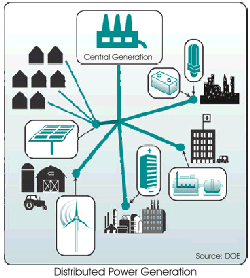Abstract - R. Morrison, MSc, Energy Management
Optimizing Exergy-Services Supply Networks for Sustainability
Robbie Morrison - 2000
Our current energy systems, particularly those reliant on fossil fuels, are – in terms of resource use, climate change, and local impacts – highly unsustainable.
 This thesis presents a generic energy system model that can be used to identify changes in system architecture, replacement technologies, and demand patterns which reduce some chosen suite of sustainability costs – for instance, depletable fuel use, CO2 output, and local air pollution – whilst maintaining energy-service levels. The model also tallies monetary cost so that beneficial changes can be traded against financial penalties, should these arise.
This thesis presents a generic energy system model that can be used to identify changes in system architecture, replacement technologies, and demand patterns which reduce some chosen suite of sustainability costs – for instance, depletable fuel use, CO2 output, and local air pollution – whilst maintaining energy-service levels. The model also tallies monetary cost so that beneficial changes can be traded against financial penalties, should these arise.
The model was developed at the University of Wurzburg, Germany, and programmed as the UNIX-based application deeco: dynamic energy, emissions, and cost optimization. deeco provides a numerical modeling environment for undertaking energy system optimization of the type just described and includes a library of common plant types.
Mathematically, the model classifies as a dynamical flow network optimization problem. The flow network itself is best described in terms of exergy, although the network currency used by deeco is energy. Exergy-service demand drives the problem.
The model is constructed as follows. An energy system of interest is abstracted as a collection of interconnected discrete plant. The plant are treated as dynamic objects, with their intertemporal energetic input/output behaviour, capacity limits, and fixed and flow-dependent costs encoded as functions or inequalities as appropriate. Abuting plant are interfaced using logical exergy connections to form a graph-theoretic flow network – the physical structure. Time-series data-sets representing exergy-service demand by location and the prevailing ambient and institutional conditions – the informational structure – complete the problem specification.
 After selection of a flow-linear cost goal to proxy for sustainability, the model steps through a sequence of time-intervals (8760 hourly intervals by default) and, assuming redundancy, optimizes the flow routing – that is, plant usage – for each interval. Specialist algorithms resolve heat-exchange conditions and store and export surplus exergy between intervals – given certain restrictions on inter-plant influence a abutting network behaviour for reasons of tractability. The storage policy implemented is not-anticipatory, but dynamic programmeming techniques could facilitate intertemporal optimization. The key modeling requirement are that the marginal plant efficiencies be independent of duty, or approximated as stepwise-decreasing, and that the selected optimization cost be linear on flow, or approximated as piecewise-increasing. The marginal plant efficiencies may be arbitrarily dependent on prior state and on ambient conditions. Upon completion, the model reports plant usage and aggregated cost statistics for subsequent interpretation.
After selection of a flow-linear cost goal to proxy for sustainability, the model steps through a sequence of time-intervals (8760 hourly intervals by default) and, assuming redundancy, optimizes the flow routing – that is, plant usage – for each interval. Specialist algorithms resolve heat-exchange conditions and store and export surplus exergy between intervals – given certain restrictions on inter-plant influence a abutting network behaviour for reasons of tractability. The storage policy implemented is not-anticipatory, but dynamic programmeming techniques could facilitate intertemporal optimization. The key modeling requirement are that the marginal plant efficiencies be independent of duty, or approximated as stepwise-decreasing, and that the selected optimization cost be linear on flow, or approximated as piecewise-increasing. The marginal plant efficiencies may be arbitrarily dependent on prior state and on ambient conditions. Upon completion, the model reports plant usage and aggregated cost statistics for subsequent interpretation.
As well as providing quantitative decision support, the model also portrays energy policy concepts – such as efficiency, renewable energy, demand management, use of storage, waste recovery, and merit-order dispatch – as interdependent components of a more general dynamical flow network optimization problem.
The thesis also extends the concepts of exergy quality and intra-plant quality matching, and advocates that use of quality mismatch when searching for potential infrastructural improvements.
The thesis concludes with a review of New Zealand energy sector policy problems that may benefit from quantitative modeling using deeco.

